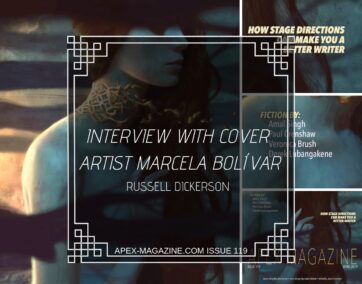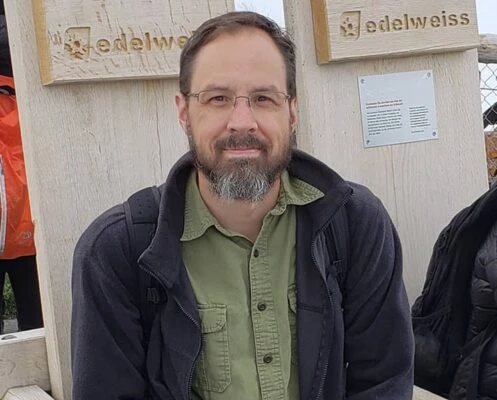
The incredible artwork of artist Marcela Bolívar once again graces the cover of Apex Magazine. Since this issue is about resistance, we wanted to find out what an amazing artist like Bolívar thinks of resistance in art.
APEX MAGAZINE: Artists throughout history have used their works to be heard, many as subtle, or even deliberate, acts of resistance. What gives visual art a “voice” that might be different from other creations, say, music or writing?
Marcela Bolívar: The big difference between those means of human expression is the time in which a lasting effect is created. Visual arts can communicate their message in only seconds, and have it remain in our minds, depending on its impact. Whereas music, whose vehicle is time, must be appreciated under certain conditions to have its message clearly understood.
On the other hand, writing conceives more complex worlds and gives more profound lessons full of nuances and metaphors, even in its simplest forms. And as reading is an act in which normally the spectator devotes all their attention, the right word can be a precise arrow that inflicts a deep wave of change within. That is the big advantage writing has over many mediums, specially the visual one, which has to permanently compete for attention through one of our most stimulated senses. But I don’t see these expressions as separate realms. Visual creation is, in many cases, the door that leads to discover these other expressions of resistance, be it through photos, logos, illustrations, etc.
Visual art is, however, no different than any other form of expression. Art is an instinctive nonconformity towards our own reality, or the human condition as a whole, which we carry and endure permanently. If the expression is honest and tries to shed a light of clarity on something still obscure, it will always be an act of protest. Through fantasies and daydreams, we can be awakened, we can be moved and touched, and our steady and comfortable points of view can be shaken forever. These fantasies, however, must be apart from the perfect world of manufactured happiness and conformity of advertisement, in which our wishes are fulfilled (or even created) but our needs are left neglected.
There is dignity in the protest. There is dignity in recognizing the state of our human condition. Art is there to resist and to see beyond that, giving hope, giving purpose.
For me, personally, the act of creating shows, more often than not, the emptiness in our lives as a longing for unattainable equilibrium. When we make evident our losses, our emptiness, we counteract a dormant existence. To me, to re-awaken will always be a revolutionary act.
AM: While some art of revolution and resistance is very overt, like Goya’s famous “The 3rdof May 1808 in Madrid,” others like Rockwell’s “The Problem We All Live With” use subtlety to pull the viewer into the created world. Do you think overt or subtle imagery works better to get a message across, or does it depend on what is being portrayed? Do you prefer, in your own work, to be overt or subtle, if you are offering a specific message?
MB: These two brutal realities show us how violence can be inflicted in very different ways, with each one being expressed accordingly to the times in which they were created. Since the invention of photography and the evolution of photojournalism, art has been freed from having to portray reality, and in my opinion, it has gained the advantage to show us these realities through different and more subtle perspectives. Subtle imagery challenges us to see what is wrong with what we accept as normal.
Since I don’t use distinguishable political contexts to express myself visually, I like to think that my work is a mixture of both subtle and overt imagery. Through bold colors and shapes, I can lead the viewer to read between hidden symbols with ambiguous meanings, or across evident metaphors.
AM: In one of our previous interviews, you talked about a piece being more of a catharsis for your mental state at the time than linked to horror. Could Goya’s or Rockwell’s pieces be considered cathartic to the viewer, or are the ideas within them too complex? Can art overreach, and merely be exploitative of the emotions around resistance and revolution?
MB: Those examples, even when political and concerning the emotions of oppressed populations, makes suffering visible, and the suffering inflicted is dignified when they become art. I don’t see these kind of images as an exploitation, but more as a natural reaction to what we perceive as unjust or hurtful.
Indeed, even though not every piece of artistic creation will be masterfully, or even tastefully, conceived, that doesn’t take away their capacity to make a phenomenon visible, and for it to even become the start of a movement.
The act of awakening and seeing reality through an aesthetic effort, focused on color harmonies and clever compositions, can be a counterpart to the hard message revealed through its brush strokes. Thus, for it to be both, an enjoyment of fine beauty can certainly be considered cathartic. It is a tension between beauty and outrage, which makes them a prime example of resistance.
AM: Rockwell’s piece is built on the concept that the viewer is put into the shoes of the people offscreen, the eponymous “Problem We All Live With.” Many of your pieces, especially ones like the beautiful “Still in a Dream,” have a similar effect of pulling the viewer into your world, moving alongside the character. How does that stylistic decision come about, a distant portrait of a person or set scene, versus a closer vision pulling the viewer right into the image?
MB: The image in question was done in a crucial moment of change in my life, in which my inability to accept what was happening around me was contrasted with a world that kept going with indifference to my confusion. So, vulnerability definitely played a role in the decision of the perspective. I understood, while making this image, that I was trying hard to keep myself asleep, but that I was inevitably going to wake up. Hence the snake hidden between the strange weeds, just about to be tread on. Since that element of menace was so important for this image, I decided to keep the perspective lower and closer. It wasn’t about a character but about a happening, an impending “scene cut.”
It is very interesting for me to see this perspective being used in Rockwell’s image, since a great part of the impact is based on his conscious decision of keeping the point of view lower. The situation gets to be lived by the viewer himself. It is a resource used often in cinematography, but it is rare to see it in traditional paintings.
AM: If given the task, or an interest in it, how would you portray modern resistance or revolution? What does portraying resistance, or their methods, say about the artist themselves?
MB: Modern resistance is, for me, to find again what is sacred in a world where everything seems to have been defiled. To go again to what is untouchable and pure and be freed from our judgmental expectations. I am not sure what that says about me, without reluctantly accepting the escapist nature of my work and therefore my personality.
It’s been a while since I’ve asked myself what would be a revolution, but I keep going back in my mind to a primal garden, secluded from this calculated and highly efficient world. A place where we make a retreat into our own selves and where we, as humans, accept our irrational nature without apologies.
It’s where our most obscure and virtuous traits coexist between harmony and chaos. A place where we consciously choose to exile to, or to leave from, as pleased.
I think parts of this garden are in every image that I make. It has been there even before it had form in my mind, and I keep filling in gaps of its codex with every idea I work on. It could be said, it is the place where I go back to again and again, in order to keep on resisting whenever I leave it.
AM: A hearty thank you to Marcela Bolívar for a captivating discussion on how an artist of her caliber perceives resistance. Make sure to visit the inspiring art galleries on her website at www.marcelabolivar.com.









